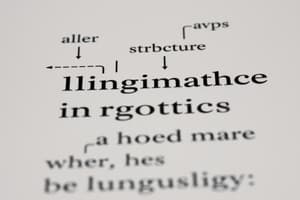Podcast
Questions and Answers
Was zeigt oft Ähnlichkeiten in ihrem Wortschatz, ihrer Grammatik und ihren Lautsystemen?
Was zeigt oft Ähnlichkeiten in ihrem Wortschatz, ihrer Grammatik und ihren Lautsystemen?
- Einzelne Sprachen
- Sprache Familien (correct)
- Regiolekte
- Dialekte
Was beschreibt die Sapir-Whorf-Hypothese am besten?
Was beschreibt die Sapir-Whorf-Hypothese am besten?
- Sprache ist unabhängig von kulturellen Einflüssen.
- Sprache kann das Denken beeinflussen. (correct)
- Die Struktur einer Sprache hat keinen Einfluss auf das Weltverständnis.
- Sprache ist ein Werkzeug für den Austausch von Informationen.
Wie trägt Sprache zur Wahrnehmung von Machtverhältnissen in der Gesellschaft bei?
Wie trägt Sprache zur Wahrnehmung von Machtverhältnissen in der Gesellschaft bei?
- Sprache wählt Verhaltensweisen, die soziale Hierarchien widerspiegeln. (correct)
- Sprache hat keinen Einfluss auf soziale Interaktionen.
- Sprache ist homogen und unabhängig von sozialen Kontexten.
- Sprache ist ausschließlich ein Kommunikationsmittel ohne soziale Bedeutung.
Was sind mögliche Faktoren für den Wandel von Sprachen?
Was sind mögliche Faktoren für den Wandel von Sprachen?
Welcher Aspekt der Sprache ist oft eng mit Kultur verbunden?
Welcher Aspekt der Sprache ist oft eng mit Kultur verbunden?
Welches Element umfasst die Regeln für die Kombination von Wörtern zu sinnvollen Sätzen?
Welches Element umfasst die Regeln für die Kombination von Wörtern zu sinnvollen Sätzen?
Welche der folgenden Behauptungen über soziale Faktoren beim Spracherwerb ist korrekt?
Welche der folgenden Behauptungen über soziale Faktoren beim Spracherwerb ist korrekt?
Was beschreibt die Pragmatik in der Sprachwissenschaft?
Was beschreibt die Pragmatik in der Sprachwissenschaft?
Was ist eine verbreitete Fehlannahme über Dialekte?
Was ist eine verbreitete Fehlannahme über Dialekte?
Welche der folgenden Komponenten bezieht sich auf die Bedeutung in der Sprache?
Welche der folgenden Komponenten bezieht sich auf die Bedeutung in der Sprache?
Welcher Bereich der Linguistik beschäftigt sich mit der Wortbildung?
Welcher Bereich der Linguistik beschäftigt sich mit der Wortbildung?
Wie beeinflusst der geografische Standort die Sprache?
Wie beeinflusst der geografische Standort die Sprache?
Welche Aussage beschreibt den Spracherwerbsprozess bei Kindern am besten?
Welche Aussage beschreibt den Spracherwerbsprozess bei Kindern am besten?
Flashcards
Sprachstruktur
Sprachstruktur
Ein komplexes Kommunikationssystem, das Symbole, Regeln und Konventionen zur Darstellung von Ideen und Konzepten verwendet.
Phonologie
Phonologie
Die Erforschung von Lautsystemen in einer Sprache. Sie umfasst die in der Sprache als verschieden geltenden Laute (Phoneme), deren Kombinationen und die Regeln für die Aussprache.
Morphologie
Morphologie
Die Erforschung der Wortbildung. Sie umfasst die Regeln zur Bildung von Wörtern durch die Kombination kleinerer Einheiten (Morpheme) und die Identifizierung verschiedener Morphemtypen wie Präfixe und Suffixe.
Syntax
Syntax
Signup and view all the flashcards
Semantik
Semantik
Signup and view all the flashcards
Pragmatik
Pragmatik
Signup and view all the flashcards
Sprachentwicklung
Sprachentwicklung
Signup and view all the flashcards
Sprachvarietät
Sprachvarietät
Signup and view all the flashcards
Sprachfamilien/Beziehungen
Sprachfamilien/Beziehungen
Signup and view all the flashcards
Sprachfamilien
Sprachfamilien
Signup and view all the flashcards
Sprachwandel
Sprachwandel
Signup and view all the flashcards
Sprache und Kultur
Sprache und Kultur
Signup and view all the flashcards
Sapir-Whorf-Hypothese
Sapir-Whorf-Hypothese
Signup and view all the flashcards
Sprache und Gesellschaft
Sprache und Gesellschaft
Signup and view all the flashcards
Sprachregister
Sprachregister
Signup and view all the flashcards
Study Notes
Language Structure
- Language is a complex system of communication that involves a set of symbols, rules, and conventions used to represent ideas and concepts.
- It enables humans to express a wide range of thoughts, feelings, and experiences.
- Language is both a creative and a social tool, constantly evolving in response to usage and societal shifts.
Components of Language
- Phonology: The study of sound systems in a language. This includes the sounds (phonemes) that are considered distinct in the language, how they are combined, and the rules for their pronunciation.
- Morphology: The study of word formation. This involves the rules for combining smaller units (morphemes) to create words, and identifying the different types of morphemes such as prefixes and suffixes.
- Syntax: The rules for combining words into meaningful phrases and sentences. This covers grammatical structures and sentence order, crucial for understanding and constructing grammatically correct sentences.
- Semantics: The study of meaning in language. This explores how words, phrases, and sentences are interpreted and how they convey meaning.
- Pragmatics: The study of language use in context. This examines how language is used in specific situations, considering the social and cultural factors affecting meaning.
Language Acquisition
- Children typically acquire language through a combination of exposure to input and innate abilities.
- Early language acquisition often follows predictable stages, involving the development of phonological, morphological, syntactic, and semantic skills.
- Environmental factors such as interactions with caregivers and access to language models significantly impact language development.
- Language acquisition is a complex process with cognitive, linguistic, and social components interplaying.
Language Variation
- Different dialects exist within a language, reflecting geographic, social, and historical influences.
- Dialect variation encompasses differences in pronunciation, vocabulary, and grammar.
- Social factors, such as the speaker's socioeconomic status, educational background, and social group, can influence dialects.
- It is crucial to avoid the misconception that one dialect is "better" or "more correct" than another.
Language Families and Relationships
- Languages are sometimes grouped into families based on shared ancestry and historical development.
- Language families often show similarities in their vocabulary, grammar, and sound systems, indicative of a common ancestor.
- The study of language families helps us understand the historical development and spread of languages across the globe.
Language and Culture
- Language and culture are deeply intertwined. The concepts and values expressed in a language often reflect the culture it originates from.
- Language shapes how cultures perceive and understand the world.
- Differences in linguistic expression can reflect diverse perspectives and beliefs across cultures.
- Cultural understanding is often necessary to interpret meanings accurately.
Language and Thought
- The Sapir-Whorf hypothesis proposes that language can influence thought, implying that the structure of a language might shape how speakers perceive and conceptualize the world.
- This perspective suggests that language is not just a tool for communication, but also a fundamental component of thinking, impacting how we categorize the world around us.
- Language influences how we conceptualize and express ideas, influencing thought processes.
Language and Society
- Language plays a significant role in social interactions and power dynamics.
- Different language registers, associated with different social contexts, might reflect and perpetuate social hierarchies.
- Language choices sometimes reflect social status, group affiliation, and power relationships.
Language Change
- Languages are constantly evolving, changing over time in various aspects, such as grammar, vocabulary, and pronunciation.
- Changes can occur due to various factors, including contact with other languages, social and cultural shifts, and innovations arising from creativity and usage.
- The study of historical language change provides insights into the past and contributes towards understanding language evolution.
Studying That Suits You
Use AI to generate personalized quizzes and flashcards to suit your learning preferences.




